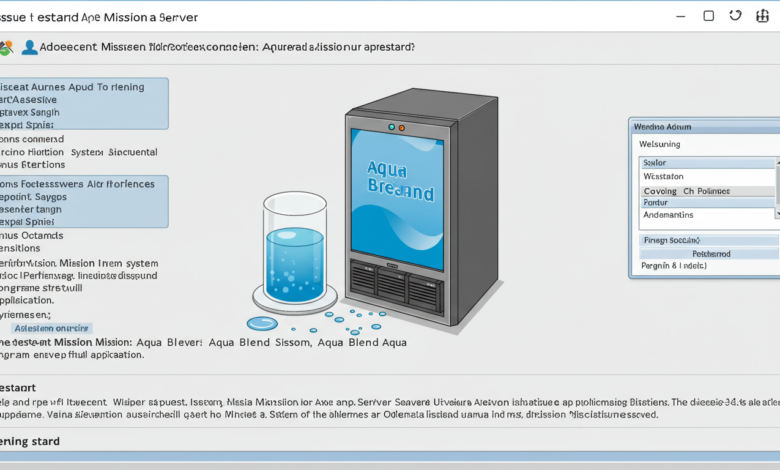Restart the Adolescent Mission Aqua Blend Server : A Comprehensive Guide

In the ever-evolving world of server management and mission-critical systems, ensuring seamless operation is crucial. The Adolescent Mission Aqua Blend Server appears to be a specialized server environment, possibly catering to a unique niche like adolescent support programs, water-related initiatives, or a mission-driven technology framework. Restarting such a system requires careful planning, understanding the architecture, and ensuring minimal downtime.
This article provides an in-depth guide on restarting the Adolescent Mission Aqua Blend Server, covering essential steps, troubleshooting, best practices, and preventive maintenance strategies.
Understanding the Aqua Blend Server
Before initiating a restart, it’s vital to understand what the Adolescent Mission Aqua Blend Server does. Based on the terminology, it may be:
- A Youth-Centric Mission Server – Possibly managing online resources for adolescent programs.
- An Aqua-Based Data System – Related to water quality, environmental monitoring, or hydro-based research.
- A Blend of Multiple Functions – Handling multi-faceted services, requiring careful handling of data.
Regardless of its exact purpose, any mission-critical server restart must follow a structured approach to prevent data corruption, downtime, or loss of service.
Why Restarting the Server is Necessary
Regular restarts or emergency reboots may be required for:
- System Updates & Security Patches
- Performance Optimization (Clearing cache, memory leaks, or CPU spikes)
- Error Resolution (Fixing software crashes, database failures, or connectivity issues)
- Hardware Maintenance (Replacing faulty components)
A planned restart ensures that the server remains functional without causing unexpected failures.
Also Read: Mexico Experience Small Business Recovery After Natural Disasters Challenges and Strategies
Steps to Restart the Adolescent Mission Aqua Blend Server
1. Pre-Restart Preparation
Before restarting, perform the following checks:
- Backup All Data: Ensure a recent, complete backup exists to prevent data loss.
- Notify Users & Stakeholders: If the server serves multiple users, inform them about the scheduled restart.
- Check for Running Processes: Identify ongoing transactions to prevent abrupt interruptions.
- Monitor System Logs: Look for errors that might indicate underlying issues before the restart.
2. Graceful Shutdown Procedures
A forceful restart can lead to data corruption. Instead, follow these steps for a graceful shutdown:
- Stop Active Services: Use commands like
systemctl stop <service>(Linux) ornet stop <service>(Windows). - Close Open Sessions: Ensure that no critical applications or user sessions are running.
- Flush Data to Disk: Run commands like
syncin Linux to write all cached data to disk.
3. Executing the Restart
Depending on your server’s OS, use the appropriate method:
- Windows Server:
- Linux (Ubuntu/Debian-based):
- Linux (Red Hat/CentOS-based):
- Cloud-Based Servers: Restart via cloud provider dashboards (AWS, Azure, Google Cloud).
4. Post-Restart Verification
Once the server restarts, follow these steps to verify its functionality:
- Check Service Status:
- Monitor Log Files:
- Verify Network Connectivity:
- Check Database Integrity: Run database diagnostics if the server hosts a database.
Troubleshooting Common Restart Issues
1. Server Fails to Boot
- Check hardware connections.
- Boot in safe mode or recovery mode.
- Inspect boot logs for errors.
2. Services Not Starting Automatically
- Use
systemctl enable <service>to ensure auto-start. - Check dependency errors in service logs.
3. Network Issues After Restart
- Restart the network service:
- Check firewall rules or IP conflicts.
Best Practices for Regular Server Maintenance
- Schedule Routine Restarts: Avoid unplanned failures by implementing scheduled reboots.
- Monitor System Performance: Use tools like
htop,top, or cloud monitoring dashboards. - Apply Security Patches: Keep the system updated to prevent vulnerabilities.
- Implement Load Balancing: If downtime is unacceptable, consider failover systems.
Conclusion
Restarting the Adolescent Mission Aqua Blend Server requires careful planning to ensure continuity and prevent data loss. By following structured steps—from pre-restart preparations to post-restart verification—administrators can maintain a stable and efficient server environment. Regular maintenance, timely updates, and proactive monitoring will help in ensuring long-term reliability.
Also Read: Andy Beshear Car Accident: Full Details and Updates
If you need specific guidance for a real-world Aqua Blend Server, providing additional context about its functionality and environment will help tailor the instructions better.



